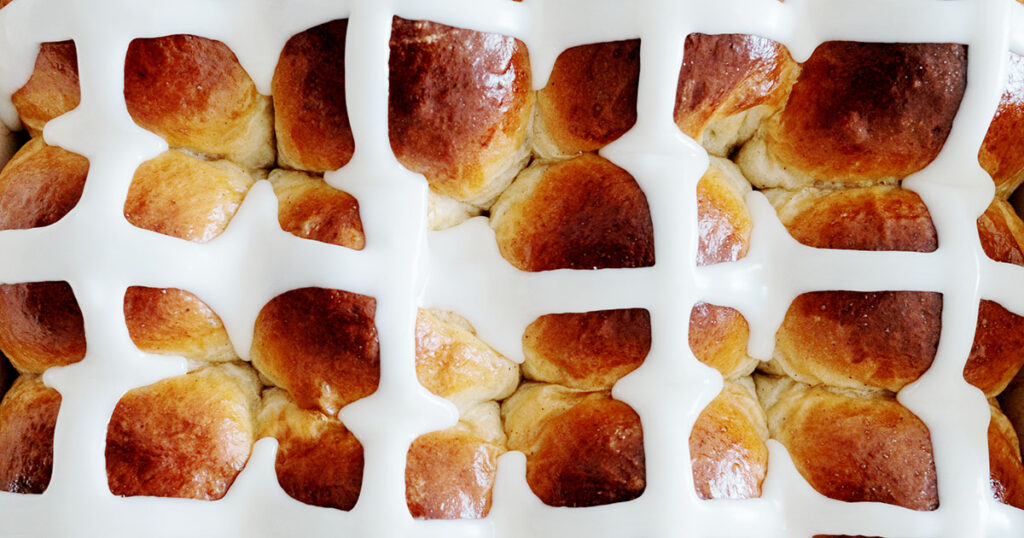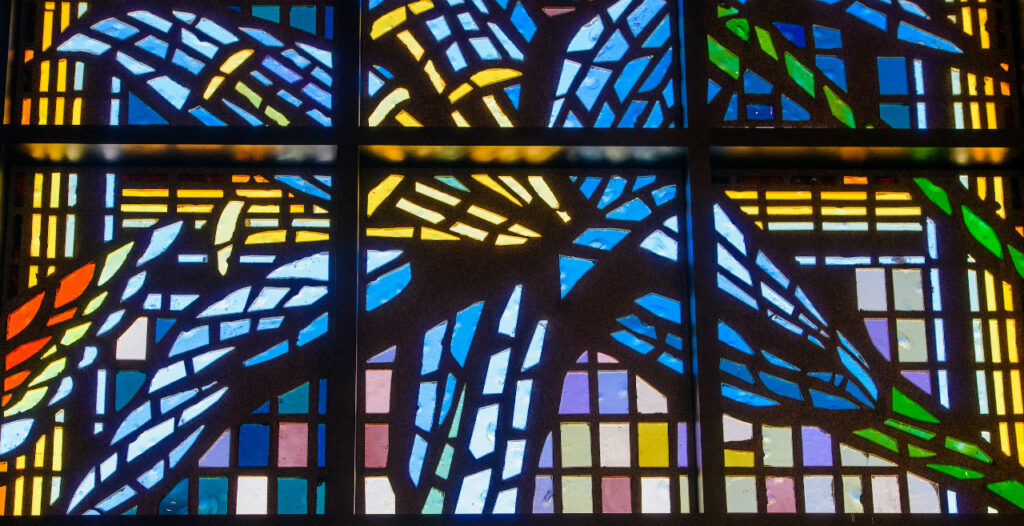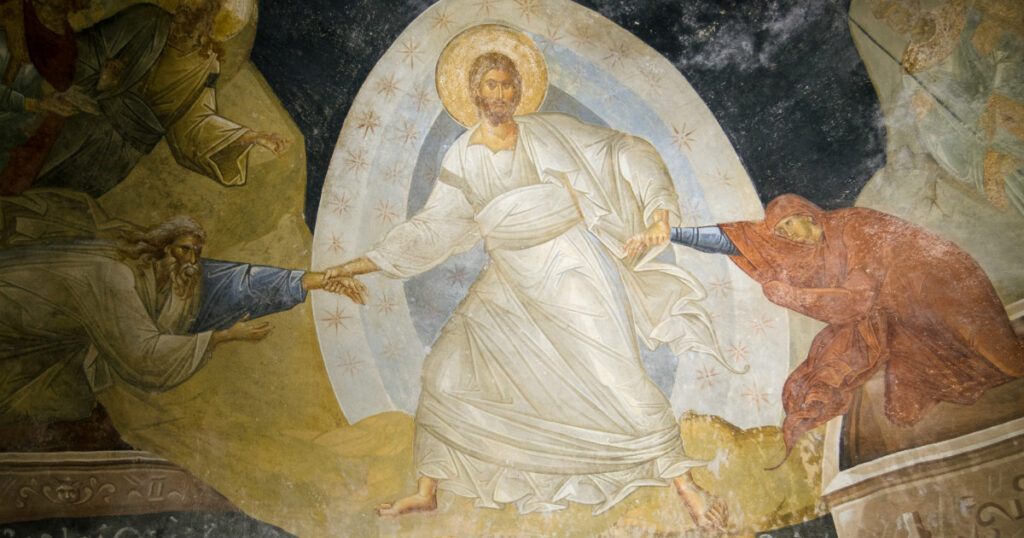There is no meal I look forward to as much as our annual Easter feast. I love Thanksgiving with its savory turkey and pumpkin pie. I love Christmas with its honey-baked ham and endless cookies. But my enjoyment of these festive meals always pales in comparison to the delight I feel as I sit down to Easter dinner.
In this meal, I see echoes of Christ’s all-atoning sacrifice. I see symbols of resurrection and new life. I see palpable reminders that the yoke of the law has been broken, and that freedom, joy and abundance are ours forever in Christ Jesus.
What is it about our Easter feast that proclaims these sweet truths to me? Can a family meal be so imbued with theological meaning? Just look and see what’s on the menu.
The main course
Since early on in our marriage, my husband and I have always served roast lamb on Easter.[1] It’s the only time that we splurge on this delicious, rather costly cut of meat. This in itself makes the Easter feast feel special for us.
More than this, though, our roast lamb entrée is full of meaning and memory. We remember Abel, offering to God “the firstborn of his flock and of their fat portions” (Gen. 4:4). We remember Abraham on the mountain, giving thanks to God for sparing Isaac and providing the lamb for the sacrifice He required (Gen. 22:1–19). We remember the long years of blood sacrifices in tabernacle and temple that God’s people made to atone for their sins — untold numbers of male lambs, without spot or blemish. We remember, too, that, “Not all the blood of beasts On Jewish altars slain, Could give the guilty conscience peace Or wash away the stain” (LSB 431:1). Most of all, we remember Jesus, the perfect Lamb of God who takes away the sin of the world (John 1:29).
My favorite way to prepare our Easter leg of lamb is to prick the outside with a sharp knife and rub it all over with olive oil, garlic, rosemary, salt and pepper before slow roasting in an oven or (better yet) over the grill. I usually like to eat it with a side of ground horseradish paste, which not only pairs well with the savory meat, but also reminds me of the bitter herbs, part of a traditional Passover seder, that symbolize both the bitterness of Israel’s enslavement in Egypt and the bitterness of our own inborn slavery to sin.
On the side
Next to the lamb on our table are roasted potatoes and asparagus spears. These dishes are, for me, humble reminders of Christ’s resurrection. The potatoes are pulled from the ground, just as Christ was. Asparagus, one of the first plants ready to harvest in any garden, leaps from the earth in springtime with astonishing speed. During the height of the season, when conditions are just right, a spear that is a mere nubbin poking through one morning can be eight inches high and ready to harvest the next. (The resurrection parallels are obvious.) The spears of asparagus also remind me of the spear that pierced our Savior’s side, pouring blood and water on the earth.
Though not everyone at the table cracks them open and eats them, I always serve a bowl of brightly painted, hardboiled Easter eggs. Eggs have long been a traditional Easter food, and despite the tendency of some to consider this a pagan holdover, the theological parallels are nonetheless easy to see. According to Fr. William Sanders at the Catholic Education Resource Center:
The Easter egg symbolizes the resurrection: just as a little chick pecks its way out from the egg shell to emerge to new life, so Christ emerged from the tomb to new and everlasting life. The unbroken egg symbolizes the rock tomb of our Lord; and when broken, symbolizes that He has risen from the dead. The ancient Romans had a saying, “Omne vivum ex ovo” (“All life comes from an egg”); easily, one can see how such a saying would inspire the early Christians to use the egg as an appropriate symbol for the new and everlasting life won for us through our Lord’s passion, death, and resurrection.
While our eggs are painted by our children in a rainbow of colors — reminiscent of God’s Genesis 9 covenant never again to destroy the earth with water — I also appreciate the Greek Orthodox tradition of dying Easter eggs a deep red, thus symbolizing the blood of Christ. Perhaps when our children are grown, my husband and I will switch to this simpler but no less meaningful way of dying eggs.
The bread board
Bread is an essential part of any Easter feast I prepare. As I knead the dough each year, I am reminded of heavenly manna — the bread from heaven that nourished the Israelites during their 40 years wandering in the wilderness. I recall, too, Jesus’ words, “I am the bread of life; whoever comes to me shall not hunger” (John 6:35), His miraculous feeding of the five thousand (Matt. 14:13–20) and His institution of the Lord’s Supper on Maundy Thursday: “Jesus took bread, and after blessing it broke it and gave it to the disciples, and said, ‘Take, eat; this is my body’” (Matt. 26:26).
On Easter, our ordinarily low-carb diet goes out the window, and the yeasty, buttery aroma of fresh bread hovers over the loaded table.
In the Middle Ages, bread was a staple all year round, but especially during Lent when meat, eggs and dairy were all off the menu. It’s not surprising, then, that an array of Lenten, Holy Week and Easter bread traditions sprang up around the world — kulich in Russia, columba de pasquain Italy and many others. Two breads that often make an appearance on my table are English hot cross buns and a braided loaf reminiscent of Greek tsourecki or Jewish challah.
One of the first piano pieces I learned as a child was the familiar nursery rhyme “Hot Cross Buns.” Versions differ, but I learned it this way, “Hot cross buns Hot cross buns One a penny, two a penny. Hot cross buns.” These sweet rolls are a traditional Good Friday treat in England, though I usually wait to serve them until Easter morning. In addition to the symbolism associated with bread, hot cross buns also contain an array of spices, reminding us of the spices the women brought to anoint Jesus’ body on Easter morning, and sweet dried fruits, symbolizing the sweetness of life in Christ. My favorite hot cross buns are made with a sweetened yeast bread dough loaded with tiny currants and topped by a cross piped on with cream cheese frosting.
With its warm, golden brown shine and its three strands representing the Holy Trinity, the braided loaf is always a visual high point of our Easter table. I use a basic white bread dough, cold fermented for several hours in the fridge after the first rising. I then cut the dough into three pieces, roll them between my hands into strands, and braid them on a cookie sheet. Then I let them rise again in a warm oven, brush on a milk-and-egg wash and bake. Sometimes, instead of a straight braid, I make a plaited wreath, which can be filled with Easter eggs, smaller bread rolls or a bowl of softened honey butter.
Raising our glasses
On an ordinary day, I drink mostly water and coffee. On weekends, I often enjoy a cold bottle of beer. But at Easter dinner, red wine and nonalcoholic sparkling grape juice are always the order of the day.
Why does red wine pair so well with an Easter feast? As German author, theologian and wine expert Gisela Kreglinger once shared with me, wine shows up throughout Scripture, from Genesis onward, and played a key part both in Jesus’ first miracle and His Last Supper. “Wine,” she says, “was given to make glad the hearts of men and women … and to deepen our sense of joy and gratitude.”
Wine always reminds me of Christ’s blood and His Sacrament. Having received the Lord’s Supper at His altar on Easter morning, my husband and I raise our wine glasses at Easter dinner afterward remembering the sweet mystery of communion with our Lord, our hearts overflowing with wonder and gratitude at the Resurrection.
The sweet stuff
No Easter feast would be complete without a decadent round of desserts. After the relative austerity of Lent, Easter is a perfect time to express love and delight through baking. The young people around the table, of course, are generally content to raid their Easter baskets for chocolate and jelly beans after the meal, but for those with more mature palates, options abound.
Many Germans serve an Easter cake baked in the shape of a lamb, though tortes are also common. In England, the simnel cake, featuring dried fruits and two luscious layers of marzipan, is an old favorite. In Russia, they serve pashka, a molded cross between cheesecake and custard that is both white (to symbolize Christ’s purity) and adorned with the letters chi and rho (signifying the risen Lord). Capirotada, a Mexican bread pudding associated with Good Friday, is made by steeping bread in syrup mulled with cinnamon sticks and whole cloves, which symbolize the beams and nails of Christ’s cross.
Given this broad array of possibilities, I rarely find myself serving the same dessert two years in row, although, admittedly, many of my Easter dessert recipes tend toward “bright” and “fruity”—cheesecakes, key lime pie and the like. One dish that I have made more than once is a strawberry trifle, with layers of strawberries, cream cheese pudding, angel food cake and whipped cream. Though there is no inherent theological meaning to layers of fruit and cream, it reminds me of springtime, new life and growth, and gratitude for a simple and delicious dessert.
A feast of rich food
All this good food, you may be thinking, must take an awful lot of time, money and energy to prepare. Why bother? Restaurants don’t close on Easter the way they do at Christmas. Why not just grab brunch on the way home from church and take the day off?
With all due respect to the many people who choose to do just that, I say this: Easter dinner is far too wonderful to miss. Both at the Lord’s Table and around our own tables, the Feast of the Resurrection is a day to pull out all the stops and celebrate our Savior’s victory with laughter and song, food and drink.
As we plan and prepare our Easter feasts this year, let us remember these words from Isaiah 25:6–8, which paint a glorious picture of the day God vanquishes death:
On this mountain the Lord of hosts will make for all peoples
a feast of rich food, a feast of well-aged wine,
of rich food full of marrow, of aged wine well refined.
And he will swallow up on this mountain
the covering that is cast over all peoples,
the veil that is spread over all nations.
He will swallow up death forever;
and the Lord God will wipe away tears from all faces,
and the reproach of his people he will take away from all the earth,
for the Lord has spoken.
Rich food. Well-aged wine. No tears. No reproach. In Christ, God has swallowed up death forever.
Happy Easter.
[1] I know that many Christians more traditionally eat ham on Easter than lamb. If this is the case for you, fear not: There’s theological meaning in your meal, too. Think of St. Peter, learning in Acts 10 from the resurrected Jesus about the freedom that is ours in His kingdom: “What God has made clean, do not call common.” Whenever we eat pork (which was forbidden to God’s Old Testament people), we remember this truth: We live in a new reality, one in which God’s grace makes even “common” things like us clean.





great story – we have a lot of the same traditions
The Ham of God just doesn’t go down with me. It’s got to be the Rack Of Lamb Of God.
Thank you for this post! Last week we celebrated Passover as a family using a great resource provided from the book, Celebrating Biblical Feasts. It was SO RICH with meaning, that I wanted to provide my family something similar this week for Easter. Your thoughtful post will be JUST the thing to help us celebrate the glory of our Lord. Thank you!
All of the shared information was not only interesting and informative. Many I hadn’t considered its relevance and relation to this special time of the Christian year. Thank you.